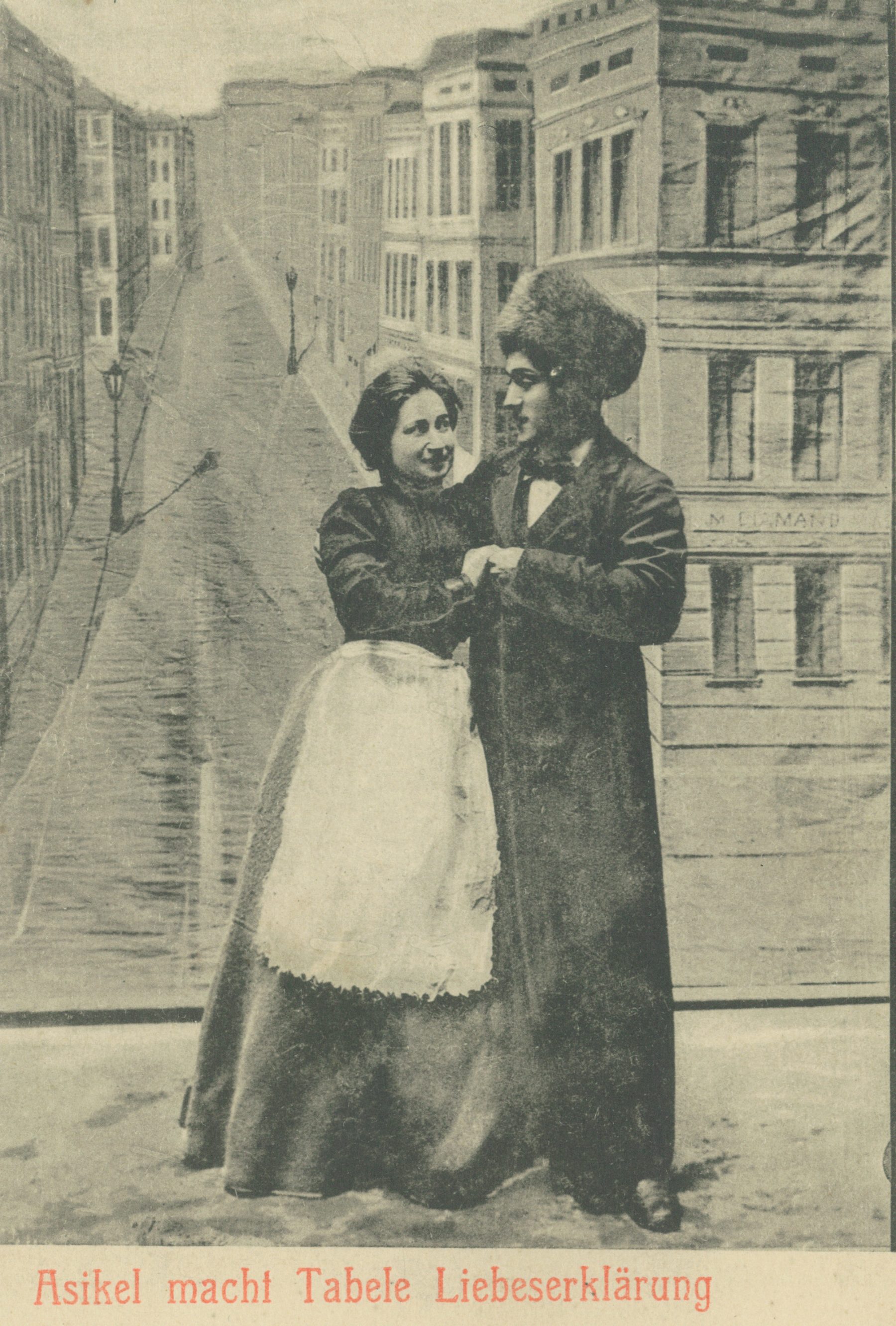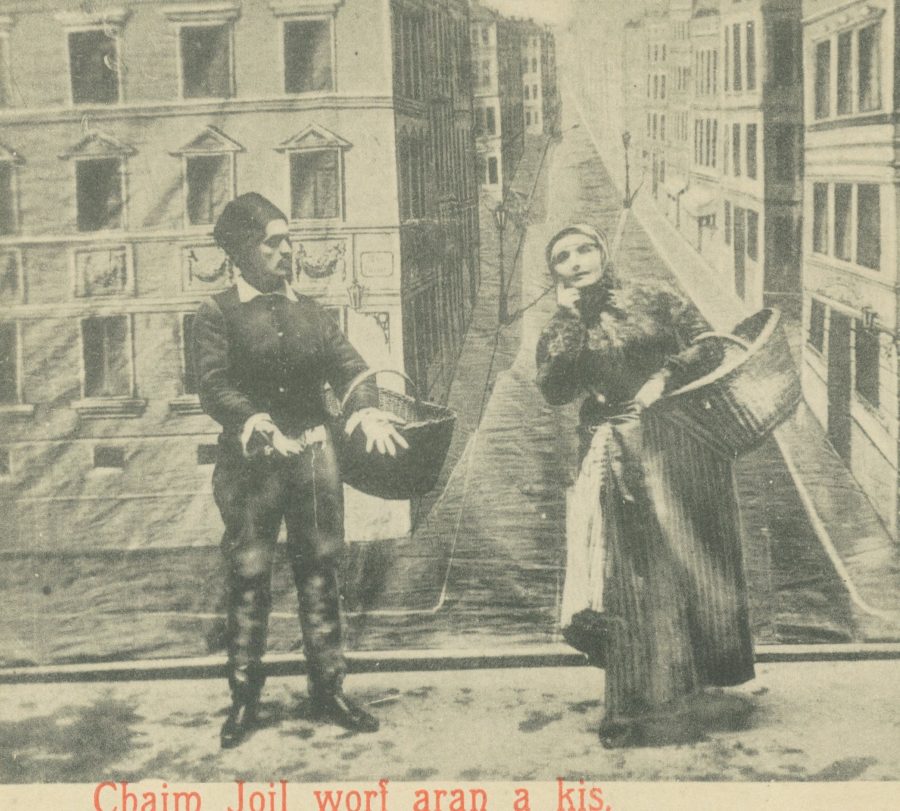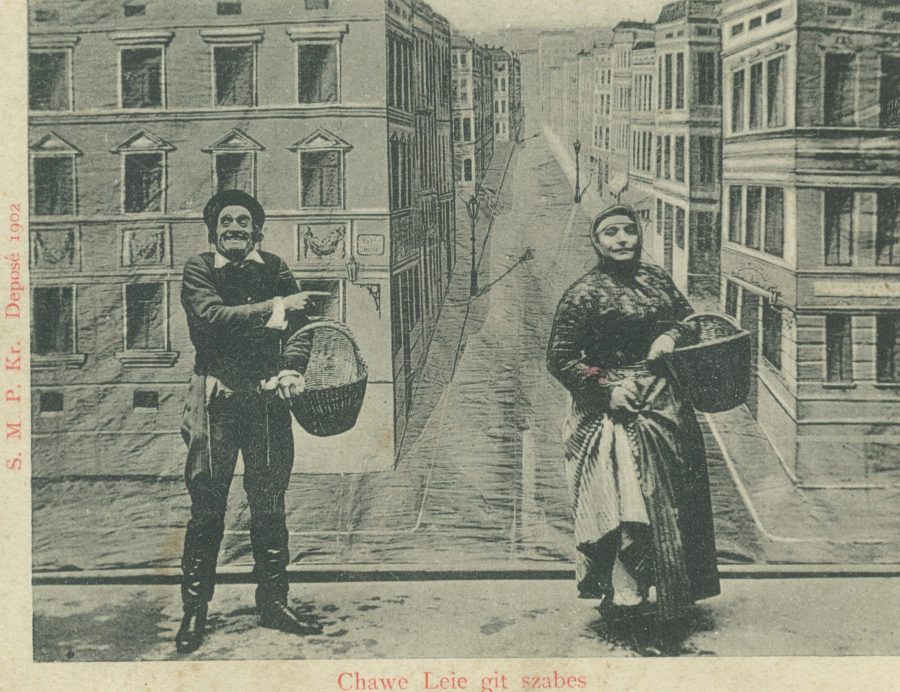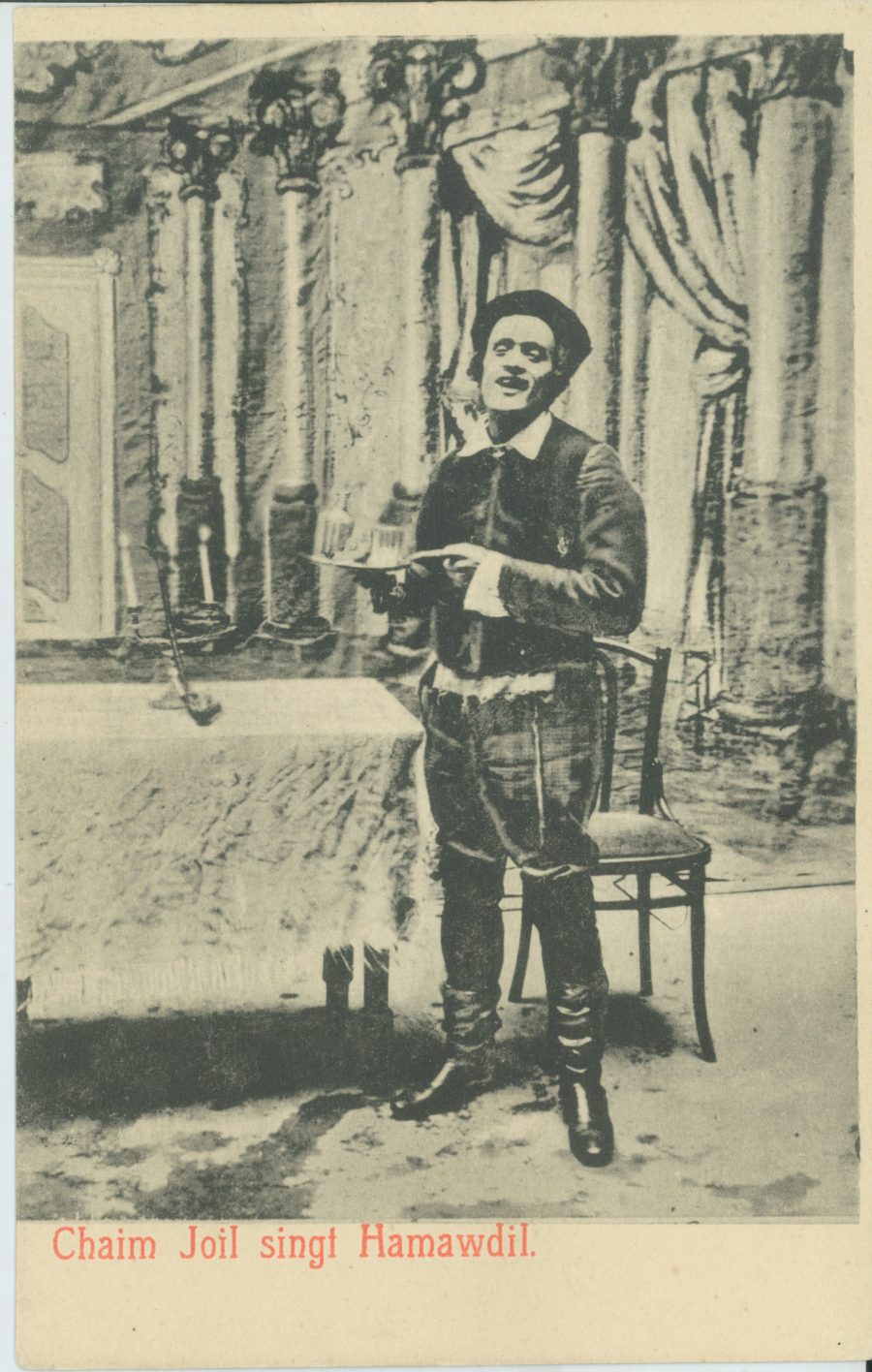
Fayvl and Saltshe Vayzenfraynd: Isaac declares his love for Taybele.
The Krakow Yiddish Theatre Postcards - a Crowdsourcing Experiment
David Mazower
Think of the pulsating energy of Motown’s dawn in Detroit. Or the soaring sounds of early jazz in New Orleans. And now imagine if all that remained of those transformative moments in American music history were a few faded black and white photographs and some scratchy 78 discs.
That’s the reality Yiddish theatre historians face as we try to reconstruct the early decades of our subject. For Detroit and New Orleans, substitute Lemberg, Czernowitz, Kishinev, and Odessa. As the sparks of early Yiddish vaudeville and operetta spread like wildfire across the Jewish world, these centers gained similarly storied reputations in the Yiddish-speaking world. And, as regional powerhouses and wellsprings of new performing talent whose stars frequently moved on to bigger cities and bigger stages, they played a similar role to their American counterparts.

Chaim Yoyel Interjects with a Kiss.
The province of Galicia in the Austro-Hungarian empire contained some of the most intensely Jewish towns and cities in the whole of Europe. In places like Lemberg, Czernowitz, Brody, Tarnopol, Przemysl, and Krakow, the proportion of Jewish residents in the late nineteenth century ranged from 30% to 75%. (Today the region is divided between Poland and Ukraine with different versions of place names in both languages).
No surprise then that Yiddish entertainers emerged from these towns in their hundreds from the 1870s onwards, often from poor and deeply orthodox families. These actors, singers and musicians were a new breed: earthy, quick-witted and khutspedik (cheeky, self-confident). They parlayed precocious talents as mimics and synagogue choristers into careers that often began by leaving home in their early teens. Their stages included courtyards, taverns, outdoor wine gardens, cafes, improvised theatres in fire stations, and local clubs.
What evidence remains of this incubatory moment in Jewish entertainment history?
The short answer is almost nothing. Few performers or local impresarios could afford to hire a photographer to take onstage publicity shots. So all we have are actors’ memoirs, some old 78s of Yiddish music theatre songs (mostly recorded by actors from Gimpel’s Yiddish theatre in Lemberg) and the occasional tattered song-sheet.

Fayvl and Saltshe Vayzenfraynd: Isaac declares his love for Taybele.
That’s why this set of postcards from Krakow is both remarkable and revealing. Issued around 1902-4, the cards show local actors in scenes from early Yiddish theatre and music-hall, complete with painted backdrops.
Each postcard contains a photograph of a theatrical sketch or scene and a brief Yiddish title or snatch of dialogue (though the Yiddish is not written in the usual Hebrew alphabet but transliterated, presumably in order to appeal to as wide an audience as possible). But the cards provide no information beyond the image and brief caption. So, for this post, we invite anyone with an interest in Yiddish theatre or song, Jewish Galicia, the history of Krakow, or Jewish or Eastern European photography, to help decipher and interpret these images.
Who are the actors? What are the songs or scenes shown on the cards? Were the photos taken on stage or in a photographer’s studio? Who issued the postcards? Are there more cards in the set? What was the typical repertoire of a Yiddish actors at this time? And what do we know about popular Jewish entertainment in Galicia in this period?
I’ll offer two pieces of the jigsaw to get us started.

Khave-Leye, Good Sabbath
The actress shown on the card ‘Chawe Leie git szabes’ is Sally Weisenfreund (c1873 - 1934), and I am fairly certain that the actor shown with her on that card and featured on ‘Chaim Joil singt Hamawdil’ is her husband Philip (c1860 - 1913). In Yiddish theatre circles they were known as Fayvl and Saltshe (or Sali) Vayznfraynd. Both came from small towns in Galicia. They spent much of their early careers performing in Krakow and Lemberg and touring farther afield to Budapest and Vienna. They stopped over briefly in London around 1901-2, when Sally featured in a Yiddish music hall in Whitechapel called the York Minster - a room above a local pub with a dubious reputation. The York Minster had a brief moment of national notoriety when two Jewish immigrant gangs (whose members frequented the Yiddish music hall) staged a fight outside the pub in October 1902. There were several injuries and one gang member died of stab wounds. At that point the Weisenfreunds moved on to New York with their three boys. All three had careers in the performing arts, notably their youngest son, Morris, who under the name Paul Muni went on to become a major star in Hollywood.
We also know something about the song ‘Chave Leie git szabes’ thanks to the pioneering scholarship of Professor Leonard Prager. In an article on London Yiddish music hall, he reproduces the text of several Yiddish songsheets from the York Minster featuring the Weisenfreunds. One of them is ‘Khave-Leye, gut shabes’ / ‘Eve-Leah, Good Sabbath’. It’s a rhyming song about the burdens Jewish women face preparing for the Friday night family meal. The opening lines (with Prager’s translation) are:

Chaim Yoyel sings Hamavdil
Der fraytikdiker tog iz a tsore, a plog,
Dos veyst yeder, a tshad un a roykh,
Men arbet mit koyekh, nisht tsu tsuzetsn arege -
Khale bakn, kalekh hakn, tsholnt rukn,
Tsupn, shtrikn,
Un dos alts muz geshen in eyn tog
Friday is a pain, a plague
Everybody knows it, charcoal fumes and smoke
You work hard, no rest for even a minute
Baking khale, chopping lime, putting in the tsholnt
Last-minute shopping, knitting
And all this has to be done in a day
(khale - white bread eaten on the Sabbath and Jewish festivals; tsholnt - a stew cooked before the Sabbath and kept warm overnight)
So, are all these scenes illustrations of Yiddish variety songs? Or is the bigger group from a full-scale Yiddish drama? Did our Krakow publisher issue these cards after the Weisenfreunds had left Europe for America? Can anyone identify the other actors? And are there other examples of commercial postcards showing images from the popular Yiddish theatre in this period? Answers please!

- Mazeltov, Father! Taybele is my bride!
